Effects of Bonding Treatment and Ball Milling on W-20 wt.% Cu Composite Powder for Injection Molding
Abstract
1. Introduction
2. Materials and Methods
3. Results and Discussion
4. Conclusions
- (1)
- The characteristics of ultrafine W-20% Cu powders changed greatly after BTBM, which significantly increased the powder loading, improved the fluidity of the feedstock, and then improved the properties and dimension accuracy of the PIM products.
- (2)
- The morphology of the powder changed from extremely agglomerated small particles to pebble-shaped smooth larger particles under the combined action of bonding, impact and rolling during BTBM, and each larger particle is composed of several small ultrafine particles. The powders after BTBM have characteristics of larger particle size, wider particle size distribution, smaller specific surface area, higher tap density and smooth surface, which are beneficial to decrease the viscosity and increase the powder loading of the feedstock.
- (3)
- The densification rate of W-20% Cu composites is mainly determined by the size of initial tungsten particles. BTBM did not increase the size of tungsten particles in W-20% Cu ultrafine powder, but eliminated the gaps and voids of ultrafine powder agglomerates, increased the powder loading of feedstock, and reduced the migration distance of tungsten particles in the sintering process. Therefore, the sintered material obtained more uniform microstructure, higher density, and better properties.
Author Contributions
Funding
Institutional Review Board Statement
Informed Consent Statement
Data Availability Statement
Conflicts of Interest
References
- Wei, W.; Chen, L.; Gong, H.R.; Fan, J.L. Strain-stress relationship and dislocation evolution of W-Cu bilayers from a constructed n-body W-Cu potential. J. Phys. Condens. Matter 2019, 31, 305002. [Google Scholar] [CrossRef]
- Micha, C.; Adam, E.J.; Ramille, N.S.; Ralph, S.; David, C.D. Microstructure and processing of 3D printed tungsten microlattices and infiltrated W-Cu composites. Adv. Eng. Mater. 2018, 20, 1800354. [Google Scholar]
- David, J.W.; Barabash, V.R.; Makhankov, A.; Plchl, L.; Slattery, K.T. Assessment of tungsten for use in the ITER Plasma facing components. J. Nucl. Mater. 1998, 258, 308–312. [Google Scholar]
- Zhang, H.Y.; Pinjala, D.; Wong, T.N.; Toh, K.C.; Joshi, Y.K. Single-phase liquid cooled microchannel heat sink for electronic packages. Appl. Therm. Eng. 2005, 25, 1472–1487. [Google Scholar] [CrossRef]
- Knuwer, M.; Meinhardt, H. Injection moulded tungsten and molybdenum copper alloys for microelectronic housings. In Proceedings of the 15th International Plansee Seminar, Reutte, Austria, 28 May 2001; Volume 1, pp. 44–59. [Google Scholar]
- German, R.M.; Johnson, J.L. Metal powder injection molding of copper and copper alloys for microelectronic heat dissipation. Int. J. Powder Metall. 2007, 43, 55–63. [Google Scholar]
- Zhu, Y.; Zhang, Q.; Meng, X.L.; Yan, L.; Cui, H. Adhesive Joint Properties of Advanced Carbon/ceramic Composite and Tungsten-Copper Alloy for the Hybrid Rocket Nozzle. Int. J. Adhes. Adhes. 2020, 102, 102670. [Google Scholar] [CrossRef]
- Müller, A.V.; Böswirth, B.; Cerri, V.; Greuner, H.; You, J.H. Application of tungsten-copper composite heat sink materials to plasma-facing component mock-ups. Phys. Scr. 2020, T171, 014015. [Google Scholar] [CrossRef]
- Tan, C.; Zhou, K.; Kuang, T. Selective laser melting of tungsten-copper functionally graded material. Mater. Lett. 2019, 237, 328–331. [Google Scholar] [CrossRef]
- Yamada, Y.; Chen, M.; Yasuoka, K. Development of Copper-Tungsten Clad-contacts for 400A-arc-less Switching of Hybrid DC Switch. IEEJ Trans. Power Energy 2019, 139, 592–597. [Google Scholar] [CrossRef]
- Myong, K.Y.; Jong, K.P.; Kyung, T.H.; Ju, C. Tungsten Skeleton Structure Fabrication Method Employed in Application of Copper Infiltration and Tungsten-Copper Composite Material Fabrication Method Thereof. U.S. Patent US 5963773A, 5 October 1999. [Google Scholar]
- Li, Y.; Liu, R.X.; Zhang, J.; Luo, G.; Qiang, S.; Zhang, L. Fabrication and microstructure of W-Cu composites prepared from Ag-coated Cu powders by electroless plating. Surf. Coat. Technol. 2019, 361, 302–307. [Google Scholar] [CrossRef]
- Ho, P.W.; Li, Q.F.; Fuh, J.Y. Evaluation of W-Cu metal matrix composites produced by powder injection molding and liquid infiltration. Mater. Sci. Eng. 2008, 485, 657–663. [Google Scholar] [CrossRef]
- German, R.M. Particulate Composites by Powder Injection Molding. In Wiley Encyclopedia of Composites; American Cancer Society: Atlanta, GA, USA, 2012. [Google Scholar]
- Ouyang, M.L.; Xu, L.S.; Zhang, Q.; Wang, C.P.; Wang, C.L.; Zhang, H.Y.; Liu, X.J. Effects of jet milling on W-10Cu wt.% composite powder for injection molding. J. Mater. Res. Technol. 2020, 9, 8535–8543. [Google Scholar] [CrossRef]
- Wang, W.; Song, J.P.; Yan, B.Y.; Yu, Y. Metal injection molding of tungsten and its alloys. Met. Powder Rep. 2016, 71, 441–444. [Google Scholar] [CrossRef]
- Song, J.P.; Qi, M.G.; Zeng, X.; Xu, L.S.; Yu, Y.; Zhang, Z.G. Metal injection moulding of W-10%Cu material with ultrafine composite powder. Powder Inj. Mould. Int. 2011, 5, 86–90. [Google Scholar]
- Kim, S.W.; Suk, M.J.; Kim, Y.D.; Moon, I.H. Micro metal powder injection molding of W-Cu nanocomposite powder. Met. Mater. Int. 2005, 11, 205–208. [Google Scholar] [CrossRef]
- Kim, S.W.; Suk, M.J.; Kim, Y.D. Metal injection molding of W-Cu powders prepared by low energy ball milling. Met. Mater. Int. 2006, 12, 39–44. [Google Scholar] [CrossRef]
- Kim, S.W.; Kim, Y.D.; Suk, M.J. Micropatterns of W-Cu composites fabricated by metal powder injection molding. Met. Mater. Int. 2007, 3, 391–394. [Google Scholar] [CrossRef]
- Cheng, J.G.; Wan, L.; Cai, Y.B.; Jin, C. Fabrication of W-20 wt.%Cu alloys by powder injection molding. J. Mater. Process. Technol. 2010, 210, 137–142. [Google Scholar] [CrossRef]
- German, R.M.; Hens, K.H. Identification of the effects of key powder characteristics on powder injection moulding. Met. Powder Rep. 1992, 47, 55. [Google Scholar] [CrossRef]
- Trad MA, B.; Demers, V.; Dufresne, L. Effect of Powder Shape and Size on Rheological, Thermal, and Segregation Properties of Low-Pressure Powder Injection Molding Feedstocks. J. Mater. Eng. Perform. 2019, 28, 1–12. [Google Scholar]
- Suri, P.; Atre, S.V.; German, R.M.; Souza, J.P.D. Effect of mixing on the rheology and particle characteristics of tungsten-based powder injection molding feedstock. Mater. Sci. Eng. A 2003, 356, 337–344. [Google Scholar] [CrossRef]
- Pujari, V.K. Effect of Powder Characteristics on Compounding and Green Microstructure in the Injection-Molding Process. J. Am. Ceram. Soc. 2010, 72, 1981–1984. [Google Scholar] [CrossRef]
- Fan, J.L.; Liu, T.; Zhu, S.; Han, Y. Synthesis of ultrafine/nanocrystalline W-(30-50)Cu composite powders and microstructure characteristics of the sintered alloys. Int. J. Refract. Met. Hard Mater. 2012, 30, 33–37. [Google Scholar] [CrossRef]
- Dorfman, L.P.; Scheithauer, M.J.; Houck, D.L.; Paliwal, M. Tungsten-Copper Composite Powder. U.S. Patent US6103392A, 15 August 2000. [Google Scholar]
- Fan, J.L.; Han, Y.; Liu, T.; Cheng, H.C.; Gao, Y.; Tian, J.M. Influence of surfactant addition on rheological behaviors of injection-molded ultrafine 98W-1Ni-1Fe suspension. Trans. Nonferrous Met. Soc. China 2013, 23, 1709–1717. [Google Scholar] [CrossRef]
- Ma, J.D.; Qin, M.; Zhang, L.; Tian, L.S.; Li, R. Effect of ball milling on the rheology and particle characteristics of Fe-50%Ni powder injection molding feedstock. J. Alloys Compd. 2014, 590, 41–45. [Google Scholar] [CrossRef]
- Lee, J.W.; Timilsina, S.; Kim, G.W.; Kim, J.S. A new strategy for novel binder discovery in nano and powder injection molding: A metaheuristics-assisted virtual combinatorial materials search. Powder Technol. 2016, 302, 187–195. [Google Scholar] [CrossRef]
- Gülsoy, H.; Kunal, K.; Atre, S. Powder-binder formulation and compound manufacture in metal injection molding (MIM). In Handbook of Metal Injection Molding, 2nd ed.; Elsevier: Amsterdam, The Netherlands, 2018. [Google Scholar]
- German, R.M.; Bose, A. Injection Molding of Metals and Ceramics, 2nd ed.; Metal Powder Industries Federation: Princeton, NJ, USA, 1997. [Google Scholar]
- Ni, J.; Han, K.; Yu, M. Production of Al-Si alloy feedstocks using the solvent hot mixing method. IOP Conf. Ser. Mater. Sci. Eng. 2018, 369, 12001. [Google Scholar] [CrossRef]
- Momeni, V.; Alaei, M.; Askari, A.; Rahimi, A.; Nekouee, K. Effect of carnauba wax as a part of feedstock on the mechanical behavior of a part made of 4605 low alloy steel powder using metal injection molding. Mater. Sci. Eng. Tech. 2019, 50, 432–441. [Google Scholar] [CrossRef]
- Johnson, J.L.; German, R.M. Role of solid-state skeletal sintering during processing of Mo-Cu composites. Metall. Mater. Trans. A 2001, 32, 605–613. [Google Scholar] [CrossRef]
- Johnson, J.L.; Brezovsky, J.J.; German, R.M. Effects of tungsten particle size and copper content on densification of liquid-phase-sintered W-Cu. Metall. Mater. Trans. A 2005, 36, 2807–2814. [Google Scholar] [CrossRef]
- Peng, S.; Cheng, J.; Lei, W.; Zhao, J.; Wang, Y.; Cai, Y. Preparation and characterization of Mo-15 Cu superfine powders by a gelatification-reduction process. J. Alloys Compd. 2009, 476, 226–230. [Google Scholar]
- Maneshian, M.H.; Simchi, A. Solid state and liquid phase sintering of mechanically activated W-20wt.% Cu powder mixture. J. Alloys Compd. 2008, 463, 153–159. [Google Scholar] [CrossRef]
- Hong, S.H.; Kim, B.K.; Munir, Z.A. Synthesis and consolidation of nanostructured W-10-40 wt.% Cu powders. Mater. Sci. Eng. A 2005, 405, 325–332. [Google Scholar] [CrossRef]
- Fan, J.L.; Chen, Y.B.; Tao, L.; Tian, J. Sintering Behavior of Nanocrystalline Mo-Cu Composite Powders. Rare Met. Mater. Eng. 2009, 38, 1693–1697. [Google Scholar]
- Kamal, S.K.; Sushma, Y.; Vimala, J.; Shankar, B.; Ghosal, P.; Durai, L.; Majumdar, B. Effect of processing route on densification of W-10 wt.% Cu nanocomposite using spark plasma sintering. J. Alloys Compd. 2019, 785, 1137–1143. [Google Scholar] [CrossRef]
- Guo, Y.J.; Guo, D.; Wang, S.; Gao, B.; Wang, X.; Shi, Z. Field-assisted solid phase sintering of W-20 wt.% Cu nanocomposites prepared by co-precipitation method. Mater. Express 2018, 8, 547–554. [Google Scholar] [CrossRef]
- Zhang, H.; Cao, W.C.; Bu, C.Y.; He, K.; Chou, K.C.; Zhang, G.H. Sintering behavior of molybdenum-copper and tungsten -copper alloys by using ultrafine molybdenum and tungsten powders as raw materials. Int. J. Refract. Met. Hard Mater. 2020, 88, 105194. [Google Scholar] [CrossRef]
- Lee, S.H.; Kwon, S.Y.; Ham, H.J. Thermal conductivity of tungsten-copper composite. Thermochim. Acta 2012, 542, 2–5. [Google Scholar] [CrossRef]
- Luo, G.Q.; Zhang, L.M.; Chen, W.S. Low-temperature densification and excellent thermal properties of W-Cu thermal-management composites prepared from cooper-coated tungsten powders. J. Alloys Compd. 2014, 588, 49–52. [Google Scholar]
- Kim, Y.D.; Oh, N.L.; Oh, S.T.; Moon, I.H. Thermal conductivity of W-Cu composite at various temperatures. Mater. Lett. 2001, 51, 420–424. [Google Scholar] [CrossRef]
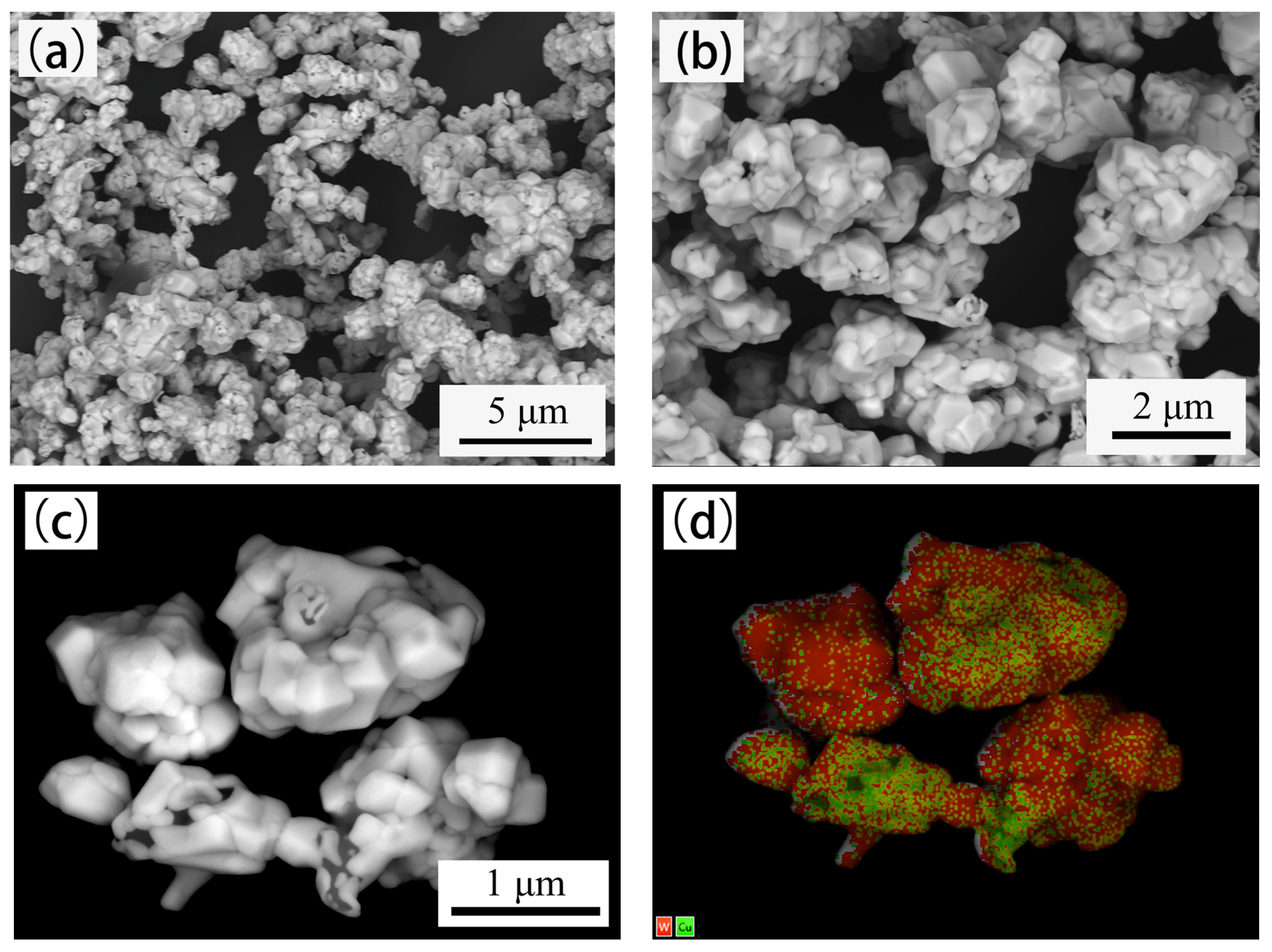
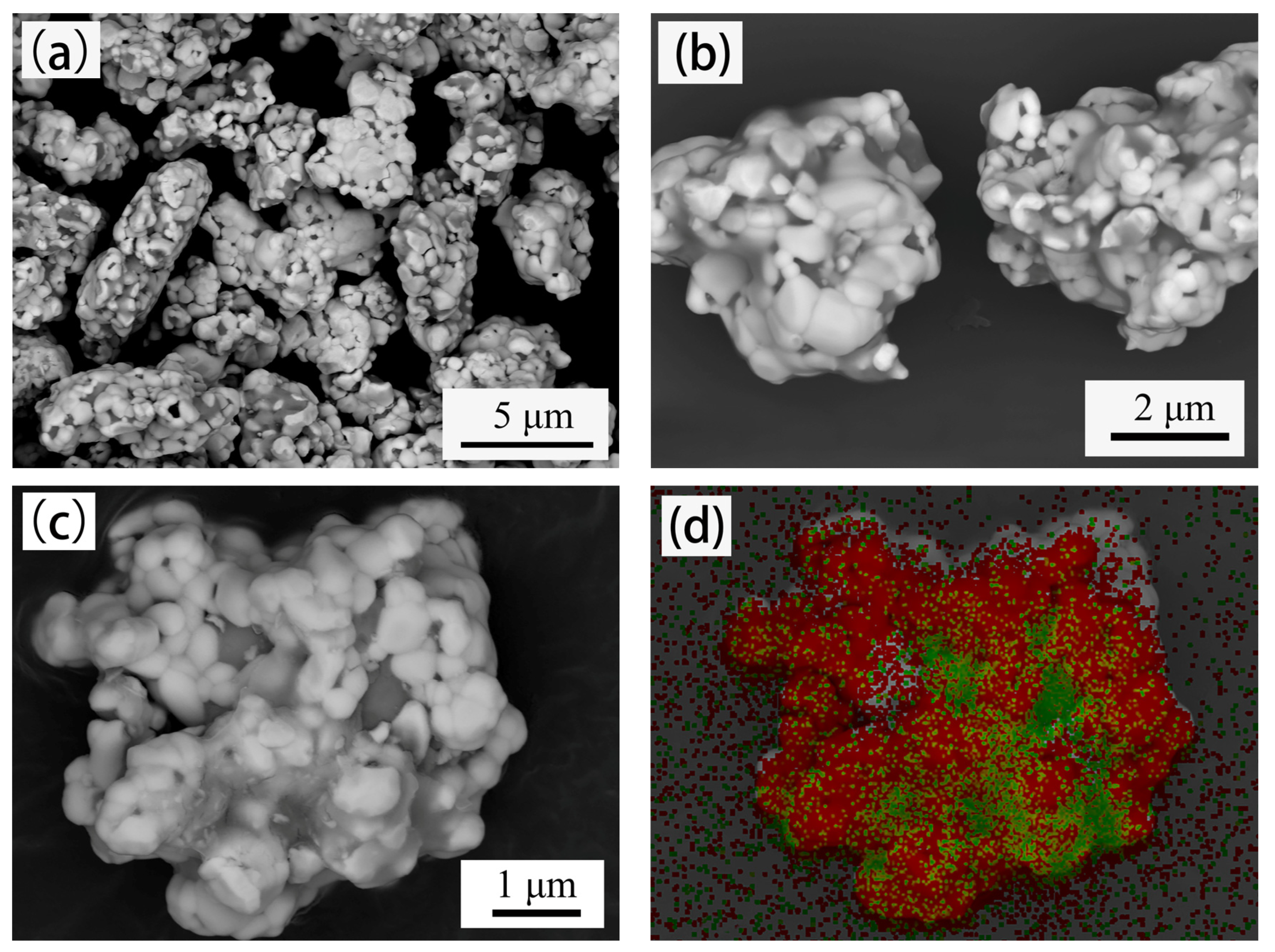
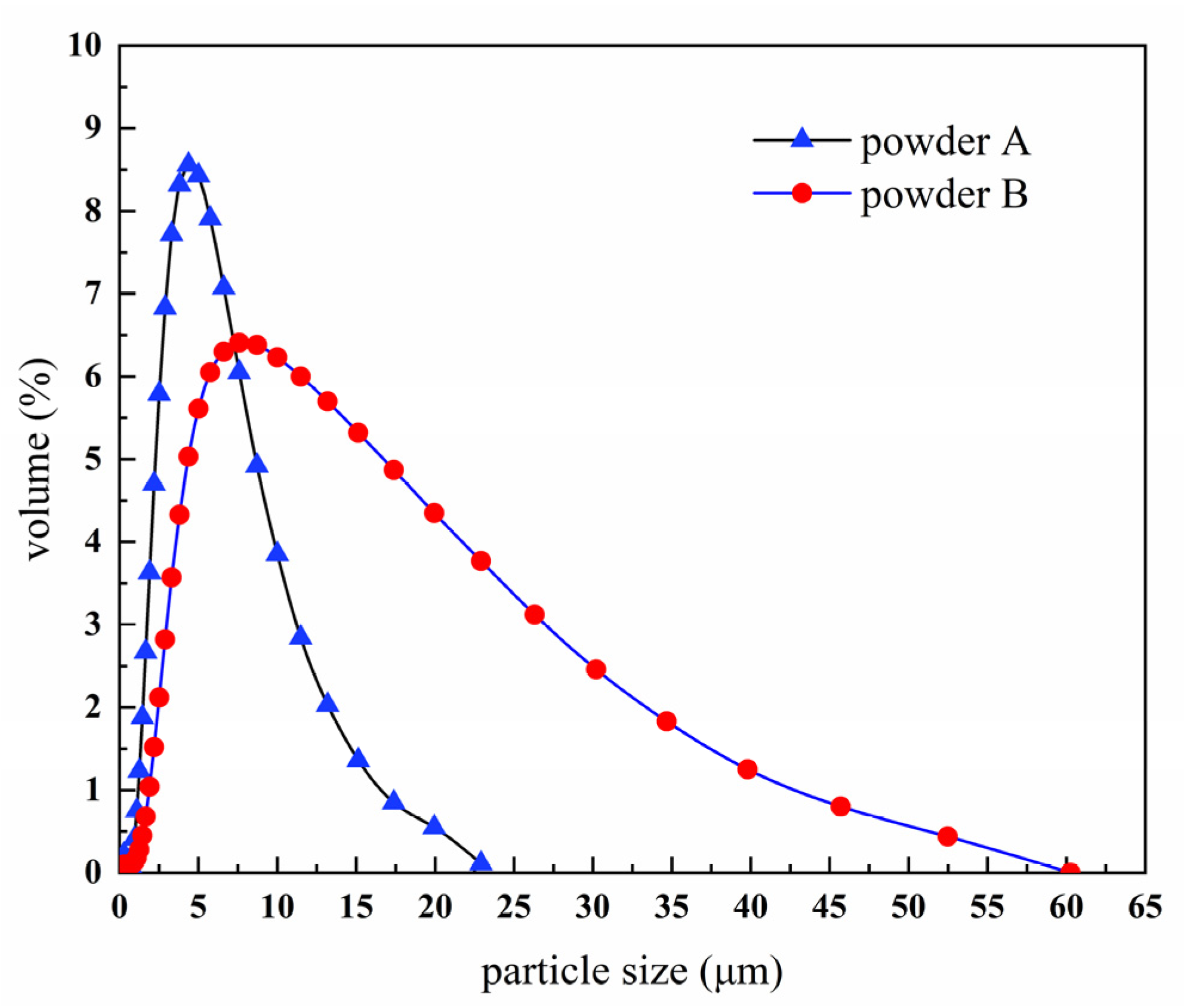
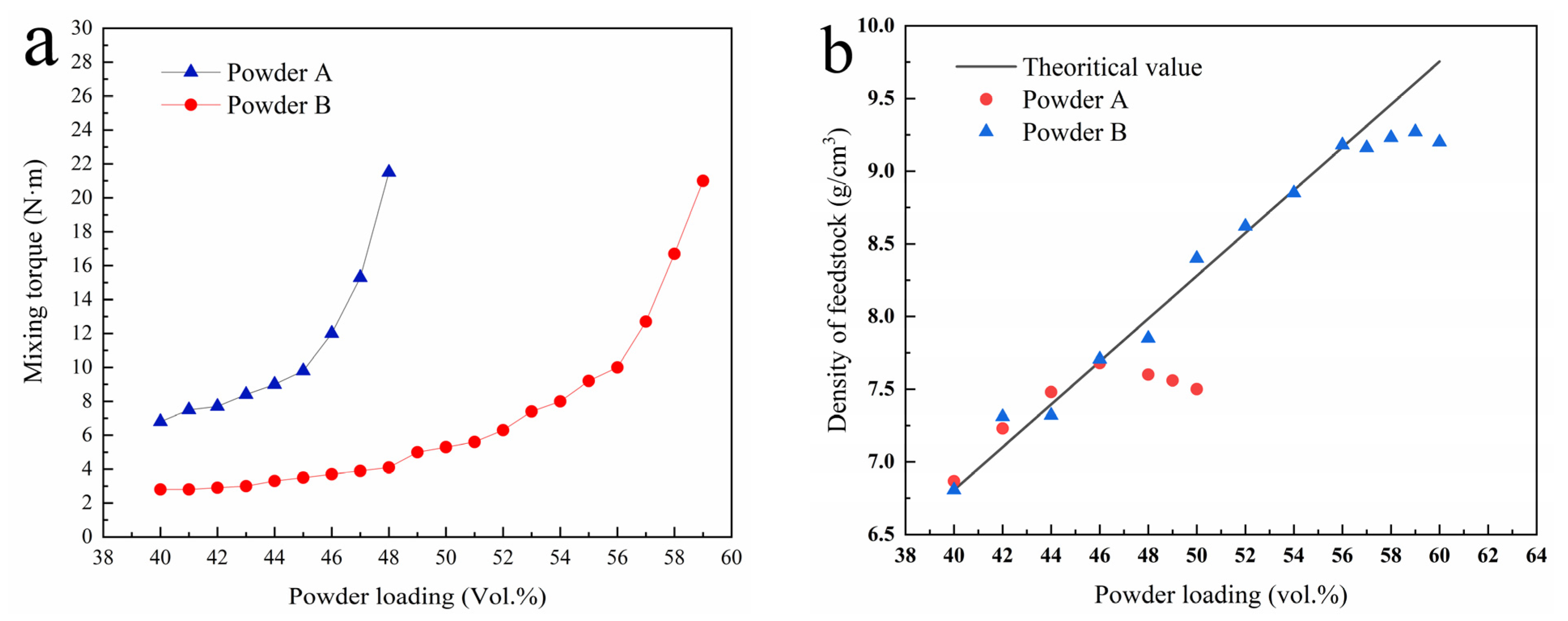
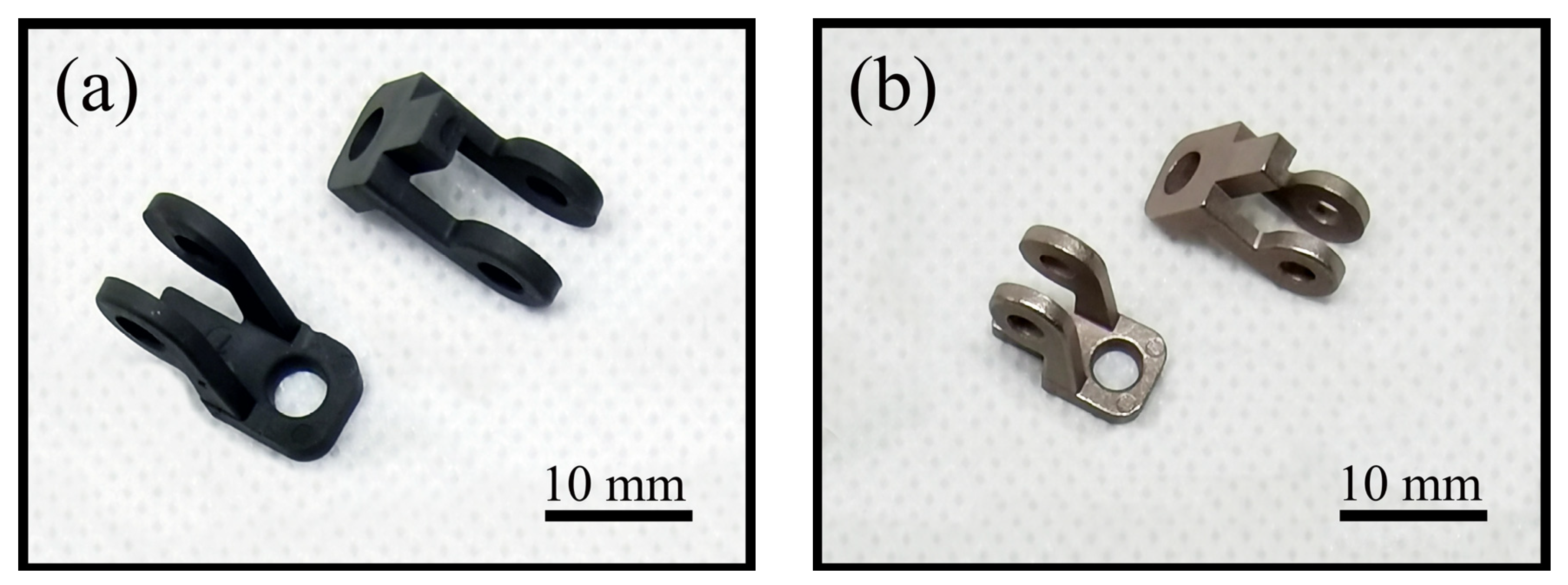
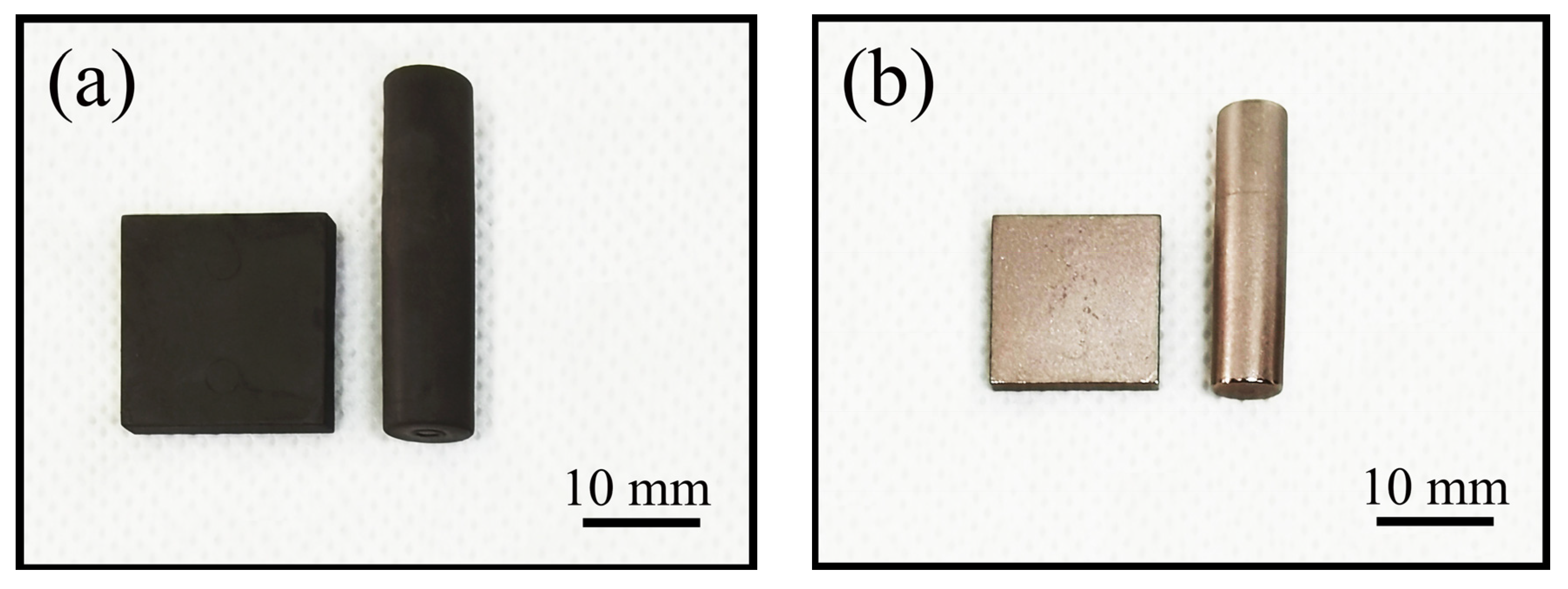

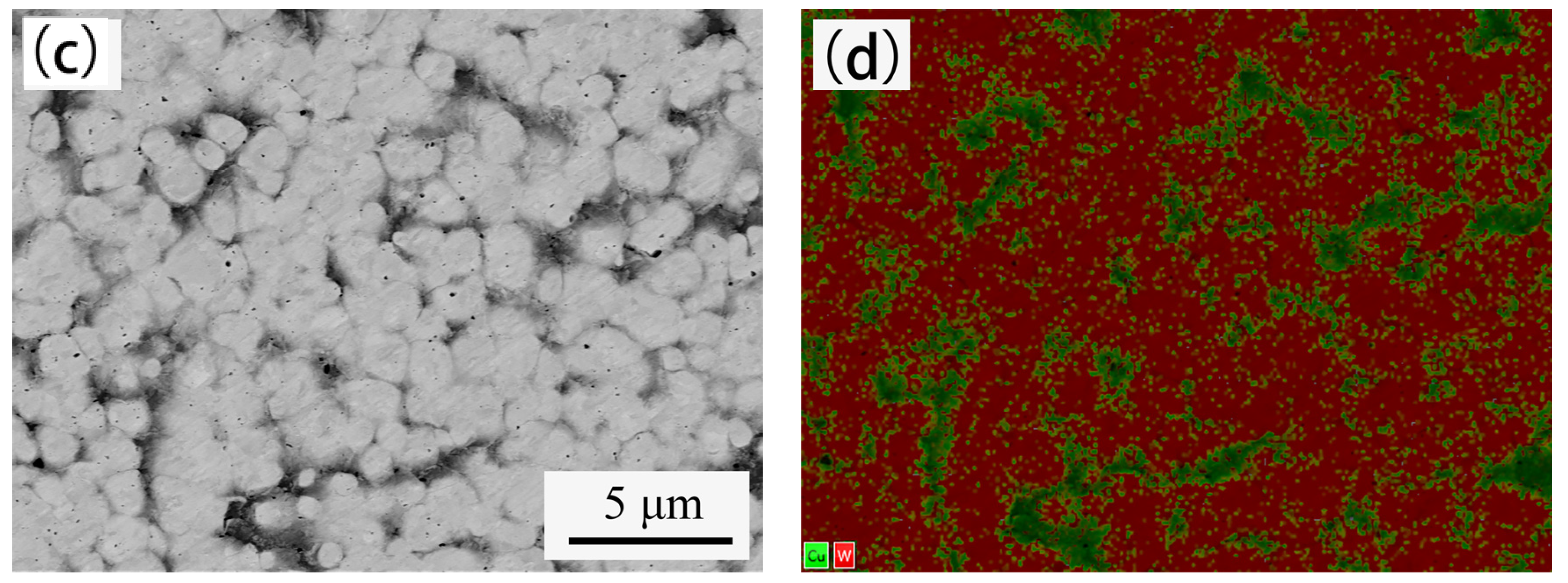
| Element | Powder A | Powder B | Sintered Composite (Powder A) | Sintered Composite (Powder B) |
|---|---|---|---|---|
| W/(wt.%) | Bal. | Bal. | Bal. | Bal. |
| Cu/(wt.%) | 20.4613 | 20.4037 | 20.1537 | 20.1096 |
| Cr/(wt.%) | 0.0073 | 0.0069 | 0.0068 | 0.0057 |
| Fe/(wt.%) | 0.0041 | 0.0058 | 0.0036 | 0.0049 |
| Ni/(wt.%) | 0.0032 | 0.0028 | 0.0039 | 0.0042 |
| Mo/(wt.%) | 0.0086 | 0.0079 | 0.0067 | 0.0075 |
| C/(wt.%) | 0.0018 | 0.0373 | 0.0031 | 0.0025 |
| O/(wt.%) | 0.2650 | 0.3821 | 0.0103 | 0.0079 |
| Powder | Particle Size Distribution | Specific Surface Area (m2/g) | Free Slope Angle (°) | Tap Density (g·cm−3) | ||
|---|---|---|---|---|---|---|
| D10 (μm) | D50 (μm) | D90 (μm) | ||||
| Powder A | 2.143 | 4.512 | 8.669 | 0.86 | 52.19 | 3.25 |
| Powder B | 2.863 | 8.011 | 22.830 | 0.45 | 40.53 | 7.22 |
| Powder | Powder Loading (vol.%) | Cave Length (mm) | Average Length of Products (mm) | Dimension Fluctuation (mm) | Fluctuation Ratio (%) | Oversizing Factor |
|---|---|---|---|---|---|---|
| Powder A | 45 | 14.80 | 11.41 | ±0.07 | ±0.61 | 1.297 |
| Powder B | 56 | 14.80 | 12.17 | ±0.04 | ±0.33 | 1.216 |
| Powder | Density (g·cm−3) | Relative Density (%) | Coefficient of Thermal Expansion (10−6/K) | Thermal Conductivity (W/mK) |
|---|---|---|---|---|
| Powder A | 15.31 | 97.8% | 8.52 | 218 |
| Powder B | 15.43 | 98.6% | 8.43 | 233 |
Publisher’s Note: MDPI stays neutral with regard to jurisdictional claims in published maps and institutional affiliations. |
© 2021 by the authors. Licensee MDPI, Basel, Switzerland. This article is an open access article distributed under the terms and conditions of the Creative Commons Attribution (CC BY) license (https://creativecommons.org/licenses/by/4.0/).
Share and Cite
Ouyang, M.; Wang, C.; Zhang, H.; Liu, X. Effects of Bonding Treatment and Ball Milling on W-20 wt.% Cu Composite Powder for Injection Molding. Materials 2021, 14, 1897. https://doi.org/10.3390/ma14081897
Ouyang M, Wang C, Zhang H, Liu X. Effects of Bonding Treatment and Ball Milling on W-20 wt.% Cu Composite Powder for Injection Molding. Materials. 2021; 14(8):1897. https://doi.org/10.3390/ma14081897
Chicago/Turabian StyleOuyang, Mingliang, Cuiping Wang, Huayu Zhang, and Xingjun Liu. 2021. "Effects of Bonding Treatment and Ball Milling on W-20 wt.% Cu Composite Powder for Injection Molding" Materials 14, no. 8: 1897. https://doi.org/10.3390/ma14081897
APA StyleOuyang, M., Wang, C., Zhang, H., & Liu, X. (2021). Effects of Bonding Treatment and Ball Milling on W-20 wt.% Cu Composite Powder for Injection Molding. Materials, 14(8), 1897. https://doi.org/10.3390/ma14081897





